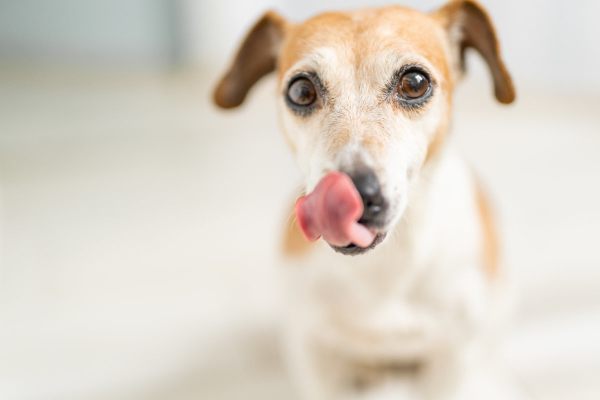You probably already know that regular chocolate and dogs don’t mix. But can dogs eat white chocolate? Or is white chocolate bad for dogs too? As integrative veterinarian Dr. Julie Buzby explains, white chocolate is far less toxic than other forms of chocolate, but that doesn’t mean you should give it to your dog.

Most pet owners know that dogs should not eat milk chocolate, dark chocolate, or baker’s chocolate. But what about white chocolate? Since it is still chocolate, is white chocolate as bad for dogs as other forms of chocolate? Or can dogs eat white chocolate without batting an eye?
In order to answer these questions, you need to know what makes most forms of chocolate so dangerous for dogs to begin with.
Why is chocolate bad for dogs?
Chocolate is toxic for dogs because it contains two chemical compounds, theobromine and caffeine, which are both stimulants. Collectively, these compounds are called methylxanthines. If you think about how caffeine affects humans, you might understand how chocolate affects dogs.
Much like a person who just downed an energy drink or a triple shot expresso, dogs who eat chocolate may experience an increase in heart rate and blood pressure (i.e. hypertension in dogs). And higher levels of theobromine and caffeine can cause more severe symptoms such as:
- Restlessness and tremors
- Vomiting and diarrhea
- Increased thirst in dogs and increased urination
- Heart arrhythmias and seizures in dogs
- Unsteady gait (dog is wobbly and off balance)
- Increased temperature
And in some cases, chocolate can kill a dog.
Are different types of chocolate more or less dangerous for dogs?
There are several types of chocolate, which run the gamut from white chocolate to milk, semi-sweet, dark, and baker’s chocolate. The amount of fat and sugar versus chocolate liquor (the base form of chocolate that comes from cacao seeds) that goes into the chocolate will change the flavor of it as well as the amount of theobromine and caffeine present. The darker the chocolate, the more methylxanthines are found inside. This makes baker’s chocolate and dark chocolate the most dangerous.
Is white chocolate bad for dogs?
Since white chocolate has the lowest amount of theobromine and caffeine, it is less dangerous than other forms of chocolate. If a dog eats a large amount of white chocolate, he or she may exhibit signs of chocolate toxicity or GI upset. But in small amounts, white chocolate by itself is unlikely to hurt or kill a dog.

Can dogs eat white chocolate?
So does this mean that it is fine to give your dog white chocolate then? Well, not necessarily.
Although white chocolate is low in the dangerous compounds theobromine and caffeine, it is high in fats and sugars. This means it could still cause your dog some significant GI distress (e.g. vomiting or diarrhea). And eating chocolate could potentially trigger pancreatitis in dogs, a dangerous inflammation of the pancreas.
There are so many better, healthier snacks out there for your canine companion. So it is wise to just avoid letting your dog eat chocolate altogether! If you want to share your snack with your dog, stick to safer options like fruits, vegetables dogs can eat, or plain popcorn.
That said, some dogs are mischievous when it comes to eating things they shouldn’t. So you might find yourself wondering how much white chocolate dogs can eat safely or if certain white chocolate-containing treats are worse than others.
How much white chocolate is dangerous for a dog?
The good news is that white chocolate on its own (e.g. white chocolate bars, white chocolate chips, and white chocolate Hershey’s kisses) is unlikely to cause chocolate toxicity. According to the chocolate toxicity calculator on the Merck Veterinary Manual website, it would take 5 pounds of white chocolate to cause toxicity in a 10-pound dog. However, the fat and sugar content in the chocolate could still cause a pretty significant upset stomach.
Relatively safer foods containing white chocolate
Even some of our favorite snacks and candies may be safe if (accidentally) ingested. White chocolate-covered pretzels, white chocolate Reese’s, and white chocolate Kit Kats tend to be less dangerous than their milk chocolate or dark chocolate cousins. But they could still cause vomiting or diarrhea in some dogs.
And white chocolate ice cream probably won’t cause chocolate toxicity either. But because many pups don’t tolerate dairy products well, white chocolate ice cream could cause some gastrointestinal upset.
More dangerous products containing white chocolate
However, while the white chocolate itself might not be toxic, certain treats containing white chocolate could still be dangerous for your dog. For example:
- Macadamia nuts covered in white chocolate can make dogs sick even in small quantities because macadamia nuts are toxic to dogs.
- Sugar-free white chocolate or baked goods containing white chocolate and the sugar substitute xylitol are also dangerous because xylitol is toxic for dogs.
- White chocolate covered raisins can cause raisin toxicity in dogs.
- The high sugar and fat content of certain chocolate products (like white chocolate cocoa butter) can increase the risk of pancreatitis in dogs.
- White chocolate peppermint bark may cause GI upset since dogs shouldn’t have peppermint.
- If your dog ate a lot of white chocolate, wrappers and all, the wrappers could potentially cause a GI obstruction.

What should you do if your dog eats white chocolate?
If your dog has eaten chocolate, one option is to use the chocolate toxicity calculator to gather more information. By entering your dog’s weight plus the type and amount of chocolate consumed, you may be able to get a general idea of if an emergency vet visit is necessary.
However, please remember that the chocolate toxicity calculators are just a guideline and are not intended to replace veterinary advice. Young or old dogs, or dogs with certain medical conditions may be more susceptible to the effects of chocolate. And sometimes it can be hard to know for sure how much chocolate your dog ate, which can skew the results of the calculator.
Plus, as just discussed, it is also important to consider if your dog could have eaten other potentially toxic foods along with the chocolate. This can change the outcome and recommended plan drastically.
Consult a pet poison control center or your veterinarian
If you have any concerns about whether your dog has eaten a toxic food or toxic amount of chocolate, the best thing to do is call Pet Poison Helpline or the ASPCA Poison Control Center. Both companies are staffed with teams of veterinary toxicologists who can give you advice about how to proceed. They may tell you to simply watch your pup. Or they may recommend you seek veterinary care. (There is a fee associated with the consultation, but it is well worth it.)
Alternatively, it never hurts to call your regular veterinarian and ask for advice. In some cases, he or she may be able to put your mind at ease. But in other situations, your vet may still recommend calling one of the poison control centers to get the advice of a veterinary toxicologist.
Along the same lines, some vet clinics are set up to handle toxicity cases. But others might recommend heading to a 24-hour center. Whatever your vet advises you to do, know that he or she has your dog’s best interests in mind.
What is the treatment for eating white chocolate?
Most of the time, no treatment is necessary when dogs eat white chocolate. But in the event that your dog did recently consume a potentially dangerous amount of chocolate, the veterinarian may start by inducing vomiting. This is a good way to get a fair amount of the chocolate out of your dog’s system. However, if the chocolate is no longer in the stomach, it won’t be very effective.
Additionally, the vet may give your dog activated charcoal to help bind up the toxins that are still circulating in your dog’s body and/or put your dog on IV fluids. And he or she will treat any symptoms your dog is showing. This may include using anti-nausea medications like Cerenia for dogs or other supportive care measures.
Note: Consuming other toxic foods along with the white chocolate may change the need for treatment or the treatment plan. Your veterinarian will determine what is best for your dog.
Paws off the white chocolate

The good news about white chocolate is that it isn’t as harmful to dogs as other chocolate types. But because the fat and sugar in chocolate can make dogs sick, it is still best practice to keep it out of paw’s reach.
Should you be concerned your dog could have eaten a toxic amount of chocolate or eaten another toxic food, please reach out to your vet or a pet poison control center immediately. It is better to be safe than to wish you had called earlier!
Has your dog gotten into white chocolate?
Please comment below.


We welcome your comments and questions about senior dog care.
However, if you need medical advice, diagnosis, or treatment, please contact your local veterinarian.